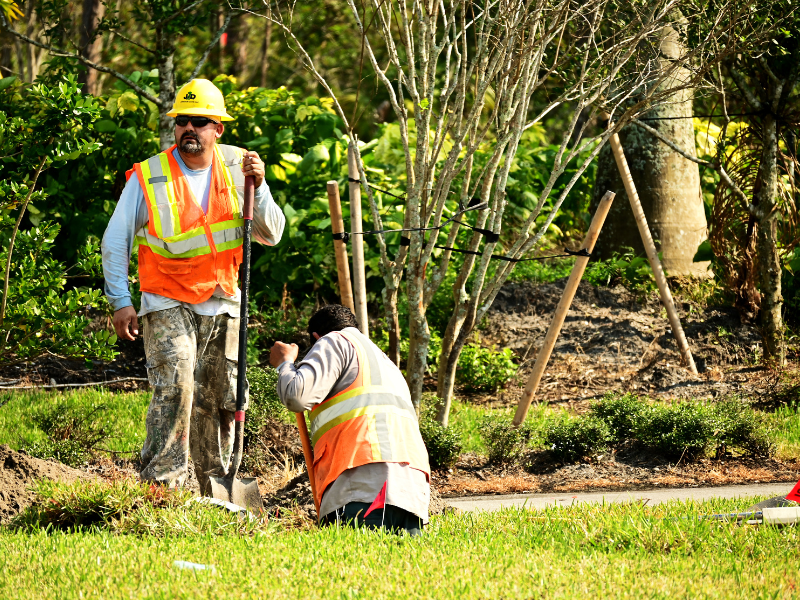Work-related injuries are among the most disruptive events for a business.
However, in many industries, like agriculture and construction, they happen often, resulting in time lost, unnecessary expenses, and sometimes significant health challenges for your employees.
Injuries at work can negatively affect morale and lead to work stoppages, lawsuits, or other outcomes.
The Bureau of Labor Statistics (BLS) reported that workplace injuries decreased 5.7 percent between 2019 and 2020. A one-year drop isn’t an anomaly. The Occupational Safety and Health Administration (OSHA) statistics indicate that worker deaths decreased from 38 to 15 per day between 1970 and 2019, while injuries decreased from 10.9 per 100 workers to 2.8 per 100 workers.
Why are there such significant reductions? The Occupational Safety and Health Act – or OSH Act – of 1970 played a major role in creating OSHA to ensure safe and healthy working conditions for American workers. As part of its mission, OSHA establishes and enforces standards and offers training and assistance to help business owners create safe working conditions.
Throughout the United States, injury rates have fallen significantly since OSHA was established.
Accidents happen, and employers must be aware of their responsibilities and rights concerning worker safety. Let’s dig into the details.
What Are Workplace Injuries?
In other words, a work-related injury is any illness or injury caused by an event or exposure at work.
Let’s look at that definition closer. It covers obvious work-related injuries, such as when a roofer falls off a roof that is in the middle of construction, or when someone is exposed to toxic chemicals in a factory that causes lung damage.
As well as illnesses and injuries that occurred at a central location, it may also include injuries that occurred elsewhere, whether they required hospitalization or not.
As an example, let’s say your employee was on his or her way to a meeting at a local restaurant.
He or she was involved in a car accident. This is a work-related injury. It wouldn’t apply if the accident occurred while your employee was commuting to work before they punched in.
The most common workplace injuries can occur suddenly, like slipping and falling or suffer over time, like developing carpal tunnel syndrome after repetitive activities.
Mental illness may be included but only if the employee can prove that the illness is connected to the work conditions.
What Kinds of Injuries Are Not Considered Workplace Injuries?
Work-related illnesses sometimes turn out not to be occupational injuries:
-When a member of the public is present at a work location but is not working.
-The injury or illness occurred at work but was caused by an event or exposure that occurred outside of work.
-When an employee eats, drinks, or prepares food for personal consumption they suffer an injury.
-An employee engages in personal tasks in the workplace outside of assigned working hours.
-An employee catches a cold or flu at work (other illnesses, such as COVID-19, tuberculosis, and hepatitis A, are exceptions).
-Employees who inflict themselves with injuries or who fight each other.
-Injury caused by drugs, alcohol, or while the employee violates company policy or commits a crime against the company.
The Top 10 Workplace Injuries
Injury rates vary by industry, with some injuries happening more frequently in one industry than another.
According to Liberty Mutual’s 2021 Workplace Safety Index, these are the most common types of workplace injuries.
1. Handling Objects
In the U.S., injuries resulting from lifting heavy boxes are common in warehousing, retail, and other places where workers regularly lift heavy boxes.
2. Falls on the Same Level
In second place falls occur on one level, such as someone slipping on a wet floor. These falls cost $10.58 billion annually.
3. Falls to a Lower Level
Whether it is falling off a roof or taking the wrong step off a ladder, injured employees in this area cost $6.26 billion annually.
4. Being Hit by Objects
In the construction and warehousing industries, being struck by heavy objects or equipment is common, and insurance companies pay out $5.61 billion every year.
5. Awkward Postures
A delivery worker steps awkwardly out of his vehicle and grasps the door with his wrist. Injuries of this type cost $4.71 billion annually.
6. Vehicle Crashes
Each year, car accidents result in $3.16 billion in workers’ compensation claims, regardless of whether it was caused by your staff driver or someone else.
7. Slip or Trip without a Fall
The heel of an admin is caught by a loose floor tile, causing her ankle to sprain. Insurance companies pay $2.52 billion in claims due to slippery or uneven walkways.
8. Colliding with Objects or Equipment
Factory workers are often involved in collisions with machinery or other objects, causing about $2.46 billion in damage.
9. Caught in Equipment or Machines
Workers are more likely to suffer job-related injuries in agriculture and factories, which cost $2.01 billion a year.
10. Repetitive Motions Involving Microtasks
The cost of injuries related to repetitive motions in the hand and shoulder system tops $1.66 billion a year when rehabilitative treatments are added in.
Injured Workers: What Should You Do?
It is your responsibility as a business owner to follow OSHA’s recommendations for a safe work environment.
Training all employees on how to operate machinery and equipment, assigning a safety monitor to high-risk jobs, and stocking first aid kits should all be part of your safety protocol.
A list of emergency contact numbers should be distributed to all employees.
Make a list of emergency medical contacts and keep a copy on hand at all times.
However, what happens if someone gets hurt at work despite your best efforts?
The life of your employee-and your liability-may depend on your ability to remain calm after an injury.
After an accident, it is important to take the following actions:
Consider the injury: Is it something that can be treated with a band-aid and some first aid cream? In case of emergency, take extra precautions, unless you have your emergency medical training. Even after the impact of a heavy box, someone may claim to feel fine, but show signs of a concussion later. In case of a head, neck, or back injury, do not move the employee. Contact first responders immediately.
Make sure that your employee is in a safe environment if they’ve been hurt by their environment. As soon as you see a toxic gas leak or other danger, evacuate the area immediately. Follow the instructions of first responders.
After the person’s injuries have been properly treated, you will need to gather information and keep records of the event.
Then, you will need to contact others who witnessed the accident to find out if the worker was wearing the proper protective equipment and handling machinery appropriately. Get a clear picture of what happened, including the times and locations, while people’s memories are still fresh.
After the immediate needs are met and the injured employee receives medical attention if needed, it is up to the employer to begin handling workers’ compensation insurance claims.
You should begin this process as soon as possible since a delay could result in the insurer denying your compensation claim. A helpful starting point would be to talk to the employee. If their injury is not severe, you will provide them with the appropriate paperwork. You might need to interview coworkers who saw the accident for additional details.
Depending on the state where you live, your paperwork may look different. It should be available online, or perhaps through the Workers’ Compensation Board of your state.
How To Submit A Claim
The process for submitting a workers’ compensation claim begins once you and the employee have collected all the necessary paperwork and have a complete understanding of what happened.
In some states, even for minor injuries, you may need to submit materials to the state’s workers’ compensation division.
The insurance company will either approve or deny your claim. If it’s approved, you and the employee will be notified of how and when payment will be provided.
These funds can be used in any way the injured party wishes, including paying their medical bills. If needed, the employee may accept this offer or negotiate a higher settlement amount.
In this case, a workers’ compensation lawyer will be able to assist them.
The worker can still take legal action even if the claim is denied. Alternatively, they can appeal through the state or ask for a reconsideration of the claim. Usually, this doesn’t happen unless the employee was seriously injured.
This procedure applies to nonfatal workplace injuries in any case. When a worker dies on the job, you would work with the next of kin.
Death benefit settlements would benefit the worker’s family members or go into the worker’s estate.
PEOPayGo Offers Free Quotes For Workers' Compensation
Businesses and self-employed contractors might want to consider getting a policy that protects their business if they get hurt at work instead of skipping workers’ compensation protection. As a leading small business insurer, PEOPayGo is a great option.
As a Professional Employee Organization (PEO), P.E.O.PayGo can help you get workers comp, bundle payroll, and HR, and perform all the headache functions of a small business, all while saving your time and money. Let our Instaquote do all the work, we don’t need much information and it takes 2 minutes. Our software does all the work for you.
Get Ready, Set, and Covered Now!




